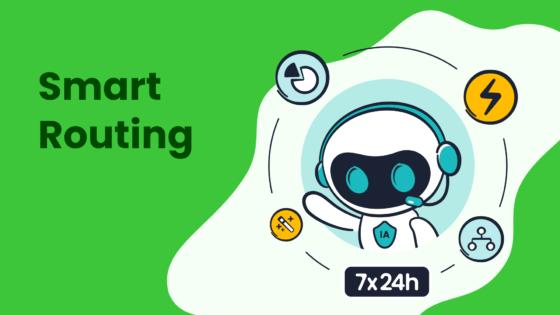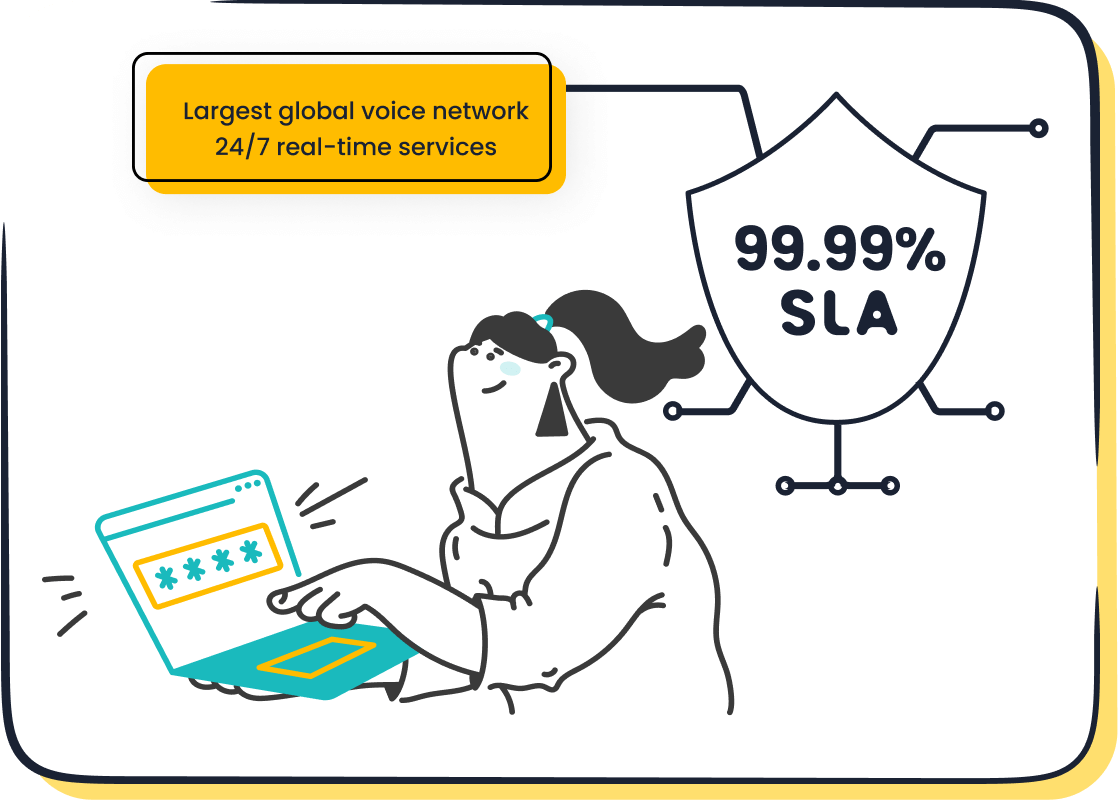How Omnichannel Contact Center Platforms Are Evolving

Omnichannel contact center platforms in 2025 drive a new era of digital transformation. Companies use advanced technology like AI, automation, and cloud systems to improve customer service across digital channels. These contact center trends reshape customer experience and make every customer interaction more meaningful. Sobot AI leads this transformation with technology that supports millions of daily interactions. Real-time analytics and unified platforms help agents boost productivity and deliver seamless customer experience. As customer expectations rise, omnichannel contact center platform solutions stand at the center of digital transformation. Businesses now see customer service as a key part of their digital strategy.
Contact Center Trends 2025
AI and Automation
Contact center trends in 2025 show a clear shift toward digital transformation. Companies now rely on ai technologies and automation to improve customer service. Artificial intelligence helps agents understand customer needs faster. For example, ai-powered chatbots can answer common questions 24/7. This reduces wait times and increases customer satisfaction. According to Gartner, by 2025, 80% of customer service interactions will use some form of ai or automation source. Sobot uses advanced technology to deliver smart automation and real-time analytics. Their platform helps businesses handle millions of digital interactions every day. Automation also allows agents to focus on complex issues, making the whole process more efficient. These trends drive the transformation of contact centers into digital-first environments.
Omnichannel Integration
Omnichannel integration stands out as one of the most important contact center trends. Customers expect seamless experiences across all channels. Omnichannel communication connects voice, chat, email, and social media in one unified system. This integration supports digital transformation by making every interaction consistent and efficient. Sobot’s omnichannel solution gives agents a single workspace for all customer data and messages. This technology improves response times and boosts agent productivity. Cloud platforms make it easier to scale and manage these systems. Digital-first companies use cloud technology to support global operations and maintain high system uptime. Omnichannel integration ensures that customers never have to repeat themselves, no matter which channel they use. These trends highlight the ongoing transformation in customer service.
AI Personalization
AI personalization shapes the future of customer experience in contact centers. Companies use ai technologies to understand each customer and deliver personalized interactions. This approach helps businesses meet rising expectations for fast and relevant service. Sobot’s ai-driven software uses real-time data to create a unique experience for every customer. Personalization improves satisfaction and builds loyalty. Research from McKinsey shows that 71% of consumers expect companies to deliver personalized experiences, and 76% get frustrated when this does not happen (source). AI makes it possible to meet these demands at scale.
Real-Time Intent
AI can detect real-time intent by analyzing customer messages and behavior. This means the system understands what the customer wants during each interaction. For example, conversational ai can recognize if a customer is asking about an order status or needs technical support. Sobot’s platform uses ai to route requests to the right agent or provide instant answers. This reduces wait times and improves the overall customer experience. Real-time intent detection helps agents respond quickly and accurately, making every experience smoother.
Note: Real-time intent analysis allows companies to predict customer needs and offer solutions before issues escalate.
Hyper-Personalized Experience
Hyper-personalized experience goes beyond using a customer’s name. AI-driven software studies past interactions, preferences, and feedback to tailor every touchpoint. Sobot’s omnichannel solution combines data from chat, voice, and email to create a complete view of the customer. This enables agents to offer recommendations and solutions that fit each customer’s needs. Hyper-personalization increases engagement and trust. Customers feel valued when companies remember their preferences and resolve issues efficiently. Businesses that use hyper-personalized experiences see higher satisfaction and loyalty.
Unified Omnichannel Contact Center Platform

A unified omnichannel contact center platform brings all customer service channels together in one place. Companies use this approach to deliver consistent and efficient customer support. Sobot’s omnichannel solution and cloud contact center help businesses manage voice, chat, email, and social media from a single workspace. This integration improves agent productivity and creates a seamless customer experience.
Seamless Channel Switching

Omnichannel support allows customers to move between channels without losing context. For example, a customer might start a conversation on live chat, switch to a phone call, and then follow up by email. The agent sees the full history in one view. This seamless channel switching reduces the need for customers to repeat themselves. Sobot’s Voice/Call Center product supports this by unifying all interactions and customer data. Agents can respond faster and more accurately because they have complete visibility into every customer’s journey.
Companies that use a unified omnichannel contact center platform see faster onboarding for agents and shorter training times. Agents do not need to learn multiple systems, which helps them resolve customer inquiries quickly.
Persistent Conversations
Persistent conversations keep the entire customer interaction history available across all channels. When a customer returns for support, the agent can review past messages, calls, and tickets. This continuity helps agents provide more personalized service and improves customer satisfaction. Sobot’s omnichannel communication tools store every interaction, making it easy for agents to pick up where the last conversation ended.
- Integration of multiple channels into one platform eliminates the need for agents to switch between disconnected systems.
- Intelligent omnichannel routing directs each customer to the best available agent, preserving context and reducing friction.
- AI and automation handle routine queries, so agents can focus on complex issues.
The Opay customer story shows the real impact of unified omnichannel support. After adopting Sobot’s platform, Opay increased customer satisfaction from 60% to 90% and reduced costs by 20%. Their agents managed inquiries across social media, email, and voice channels without missing a beat. This example highlights how a cloud-based contact center can transform customer service and deliver better business results.
Automation & Self-Service
Chatbots and Voicebots
Automation has changed the way companies deliver customer support. Chatbots and voicebots now handle many routine tasks that once required human agents. These tools use ai to answer questions, guide users, and solve problems at any time of day. For example, Sobot’s AI-powered chatbot can manage thousands of conversations at once, providing instant responses in multiple languages. This level of automation reduces wait times and improves satisfaction. According to IBM, businesses using ai chatbots can resolve up to 80% of standard customer support questions without human intervention (source). Conversational ai also helps companies understand customer intent, making each interaction more personal. Voicebots, powered by ai, can recognize speech and route calls to the right agent or provide self-service options. These solutions free up agents to focus on complex issues, making customer support teams more efficient.
Tip: Companies that use automation for customer support see faster response times and higher satisfaction scores.
Automated Workflows
Automated workflows streamline every step of the customer support process. Companies use automation to assign tickets, route inquiries, and trigger follow-up actions. Sobot’s platform offers automated workflows that help agents manage tasks with less manual effort. For example, when a customer submits a request, the system can automatically create a ticket, assign it to the right team, and send updates to the customer. This reduces errors and speeds up resolution. Automation also helps support teams track performance and identify areas for improvement. Businesses that use automated workflows report a 30% increase in productivity and a 25% reduction in handling time. These gains show how automation transforms customer support into a faster, more reliable process.
- Automated workflows ensure no request gets lost.
- AI-driven systems provide real-time insights for better decision-making.
- Support teams can focus on building relationships instead of repetitive tasks.
Omnichannel Analytics & Insights
Real-Time Dashboards
Real-time dashboards have become essential in every modern omnichannel contact center platform. These dashboards give managers and agents instant access to key metrics, such as response times, customer satisfaction scores, and channel performance. With real-time analytics, teams can spot issues as they happen and take immediate action. For example, if call wait times spike, supervisors can quickly allocate more agents to voice channels.
Sobot’s omnichannel contact center platform provides customizable dashboards that display live data from all channels—voice, chat, email, and social media. This unified view helps teams monitor customer experience and agent productivity at a glance. According to Salesforce, 72% of service teams say real-time analytics improve their ability to meet customer needs (source). By using these dashboards, businesses can make data-driven decisions and respond faster to customer demands.
Tip: Real-time dashboards help companies maintain high service levels and quickly adapt to changing customer expectations.
Predictive Analytics
Predictive analytics uses AI and automation to forecast trends and customer behavior in an omnichannel contact center platform. This technology analyzes historical data to predict future needs, such as peak contact times or common support issues. Teams can then prepare resources and optimize workflows before problems arise.
Sobot’s analytics tools use AI to identify patterns in customer interactions across all channels. For example, the system can predict when customers are likely to need help, allowing agents to reach out proactively. Predictive analytics also helps improve customer experience by suggesting personalized solutions based on past behavior. Businesses that use predictive analytics report a 20% increase in customer satisfaction and a 15% reduction in operational costs.
- Predictive analytics enables smarter staffing decisions.
- AI-driven insights help companies deliver proactive support.
- Automation ensures agents focus on high-value tasks.
Omnichannel contact center platforms with advanced analytics empower organizations to stay ahead of customer needs and drive better business outcomes.
Security & Compliance
AI Fraud Detection
Contact centers face growing threats from fraud and cyberattacks. Companies now use ai to detect suspicious activity and protect customer data. AI-powered systems can analyze large volumes of interactions in real time. These systems look for unusual patterns, such as repeated failed login attempts or changes in customer behavior. When the system detects a risk, it alerts agents or blocks the transaction. Sobot’s omnichannel platform uses ai-driven monitoring to help businesses identify and respond to threats quickly. This approach reduces the risk of financial loss and builds trust with customers.
AI fraud detection tools can adapt to new threats faster than traditional security methods. They learn from every interaction and improve over time.
Many organizations choose cloud contact center technology for its scalability and security. Cloud platforms monitor key metrics like latency, uptime, and response time. These features ensure that security tools work even during peak customer interaction periods. Companies can scale their ai-driven fraud detection tools without manual intervention, keeping operations safe and efficient.
Data Privacy
Data privacy remains a top priority for businesses and customers. Regulations such as GDPR and CCPA require companies to protect personal information and give customers control over their data. Sobot’s contact center solutions use encrypted data transfer and secure storage to meet these requirements. The platform supports compliance by tracking access and providing audit trails for every interaction.
- Sobot’s cloud infrastructure adapts to seasonal spikes or sudden changes in demand without downtime or extra costs.
- The system maintains 99.99% uptime, ensuring data privacy protections stay active at all times.
Companies that use cloud contact centers benefit from real-time scaling and strong privacy controls. The global market for cloud contact centers is expected to reach $77 billion by 2032, growing at a CAGR of 25.1% (source). This growth reflects the need for secure, compliant, and scalable solutions. Sobot’s commitment to security and privacy helps businesses build customer loyalty and meet regulatory standards.
Cloud Contact Center Technology
Scalability
Cloud contact center technology gives businesses the power to grow fast. Companies can add new agents or support more customers without buying extra hardware. This flexibility helps organizations handle busy seasons or sudden spikes in demand. For example, Sobot’s cloud contact center supports over 6 million online communications and 3 million phone calls every day. The system keeps running smoothly with a 99.99% uptime. Businesses do not worry about downtime or slow service. Cloud platforms also help companies save money because they only pay for what they use. This makes digital transformation easier for both small and large businesses.
Tip: Cloud-based contact center solutions let companies scale up or down in minutes, not weeks.
Digital Channel Integration
Digital channel integration is a key part of modern contact center technology. Customers want to reach companies through chat, email, voice, and social media. Cloud technology brings all these digital channels together in one place. Sobot’s omnichannel solution lets agents see every message and call in a single workspace. This unified view helps agents answer questions faster and give better service. Digital-first companies use cloud contact center technology to connect with customers on their favorite platforms. According to Precedence Research, the global cloud contact center market will reach $77 billion by 2032. This growth shows how important digital transformation and cloud solutions have become. Companies that use cloud technology can quickly add new digital channels as customer needs change.
- Cloud contact center technology supports integration with tools like CRM and e-commerce platforms.
- Digital channel integration improves customer satisfaction and agent productivity.
Customer Experience Impact

Satisfaction & Loyalty
Omnichannel customer service platforms have changed the way companies build satisfaction and loyalty. Customers now expect to reach support through chat, email, voice, or social media without repeating information. When companies deliver a seamless experience, customers feel valued and understood. Sobot’s unified platform helps businesses provide this level of service by connecting every channel in one workspace.
- Omnichannel strategies reduce customer effort and increase satisfaction.
- Seamless experiences foster trust and consistent branding.
- Personalized interactions improve retention and loyalty.
- Leading brands like Amazon, Starbucks, and IKEA use omnichannel approaches to boost engagement and loyalty.
- CRM systems and automation tools synchronize customer data, enabling consistent service.
Sobot’s platform uses AI and automation to personalize every customer interaction. Companies see higher satisfaction scores and stronger loyalty when they use these tools. Future trends, such as real-time feedback and mobile enhancements, will make customer experience even better (source).
Customers who enjoy a smooth journey are more likely to return and recommend the brand to others.
Agent Productivity
Agent productivity plays a key role in delivering great customer service. A unified omnichannel platform gives agents access to all customer data and history in one place. Sobot’s solution allows agents to switch between channels without losing context. This reduces time spent searching for information and helps agents resolve issues faster.
Agents can handle more requests with less effort. Automation takes care of routine tasks, so agents focus on complex problems. Companies report a 30% increase in productivity after adopting omnichannel customer service platforms. Sobot’s real-time dashboards and workflow automation help teams track performance and improve every customer experience.
Efficient agents create better experiences for customers and help businesses grow.
Contact center technology continues to drive the transformation of omnichannel platforms in 2025. Companies see new trends like AI, automation, and analytics changing how they serve customers. Sobot’s technology supports this transformation by unifying channels and boosting efficiency. For example, Opay improved satisfaction by 30% after adopting Sobot’s solutions. These trends show that businesses must embrace advanced technology to stay ahead. The future of customer contact will bring even more transformation as technology and trends evolve.
Companies that invest in the right technology will lead the next wave of transformation in customer experience.
FAQ
What is an omnichannel contact center platform?
An omnichannel contact center platform connects all customer communication channels—voice, chat, email, and social media—into one system. Sobot’s platform enables agents to manage every interaction in a unified workspace, improving efficiency and customer experience. This approach supports digital transformation and seamless service.
How does AI improve omnichannel contact center platforms?
AI automates routine tasks, analyzes customer intent, and personalizes interactions. Sobot’s AI-powered chatbots and voicebots handle thousands of conversations daily, reducing wait times and increasing satisfaction. According to IBM, AI chatbots resolve up to 80% of standard support questions (source).
Why is omnichannel integration important for customer experience?
Omnichannel integration ensures customers receive consistent service across all channels. Sobot’s omnichannel contact center platform allows agents to access full conversation histories, reducing repetition and frustration. Companies using omnichannel strategies see higher satisfaction and loyalty rates, as shown in Sobot’s Opay customer story.
What security features do omnichannel contact center platforms offer?
Security features include encrypted data transfer, AI fraud detection, and compliance with regulations like GDPR. Sobot’s omnichannel contact center platform maintains 99.99% uptime and provides real-time monitoring, ensuring customer data stays safe and private at all times.
How does cloud technology benefit omnichannel contact center platforms?
Cloud technology enables scalability, global access, and integration with digital channels. Sobot’s cloud contact center supports millions of daily interactions and adapts to business growth. The global cloud contact center market is projected to reach $77 billion by 2032 (source).
